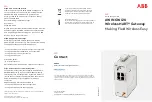
101
IEEE
Institute of Electrical and Electronics Engineers.
This
American organization was founded in 1963 and sets standards
for computers and communications.
IETF
Internet Engineering Task Force.
An organization responsible
for providing engineering solutions for TCP/IP networks. In the
network management area, this group is responsible for the
development of the SNMP protocol.
IP
Internet Protocol.
IP is a layer 3 network protocol that is the
standard for sending data through a network. IP is part of the
TCP/IP set of protocols that describe the routing of packets to
addressed devices. An IP address consists of 32 bits divided into
two or three fields: a network number and a host number or a
network number, a subnet number, and a host number.
IP Address
Internet Protocol Address.
A unique identifier for a device
attached to a network using TCP/IP. The address is written as
four octets separated with periods (full-stops), and is made up of
a network section, an optional subnet section and a host section.
IPSec
IPSec (
Internet Protocol Security
) is a VPN encryption protocol
based on TCP/IP. It is a flexible protocol with a wide range of
encryption options. IPSec is commonly used for both connections
between separate private networks and for connections between
remote PCs and private networks.
ISP
Internet Service Provider.
An ISP is a business that provides
connectivity to the Internet for individuals and other businesses
or organizations.
LAN
Local Area Network.
A network of end stations (such as PCs,
printers, servers) and network devices (hubs and switches) that
cover a relatively small geographic area (usually not larger than a
floor or building). LANs are characterized by high transmission
speeds over short distances (up to 1000 metres).
L2TP over IPSec
L2TP over IPSec is a combination of protocols commonly used to
authenticate a user (L2TP) and encrypt data (using IPSec).
MAC
Media Access Control.
A protocol specified by the IEEE for
determining which devices have access to a network at any one
time.
MAC Address
Media Access Control Address.
Also called the hardware,
physical or Ethernet address. A layer 2 address associated with a
particular network device. Most devices that connect to a LAN
have a MAC address assigned to them as they are used to
identify other devices in a network. MAC addresses are 6 bytes
long.
dua08609-5aaa01.book Page 101 Thursday, September 11, 2003 12:15 PM
Summary of Contents for OfficeConnect
Page 1: ...dua08609 5aaa01 book Page 1 Thursday September 11 2003 12 15 PM ...
Page 6: ...6 dua08609 5aaa01 book Page 6 Thursday September 11 2003 12 15 PM ...
Page 14: ...14 dua08609 5aaa01 book Page 14 Thursday September 11 2003 12 15 PM ...
Page 22: ...22 dua08609 5aaa01 book Page 22 Thursday September 11 2003 12 15 PM ...
Page 74: ...74 dua08609 5aaa01 book Page 74 Thursday September 11 2003 12 15 PM ...
Page 84: ...84 dua08609 5aaa01 book Page 84 Thursday September 11 2003 12 15 PM ...
Page 90: ...90 dua08609 5aaa01 book Page 90 Thursday September 11 2003 12 15 PM ...
Page 98: ...98 dua08609 5aaa01 book Page 98 Thursday September 11 2003 12 15 PM ...
Page 104: ...104 dua08609 5aaa01 book Page 104 Thursday September 11 2003 12 15 PM ...












































